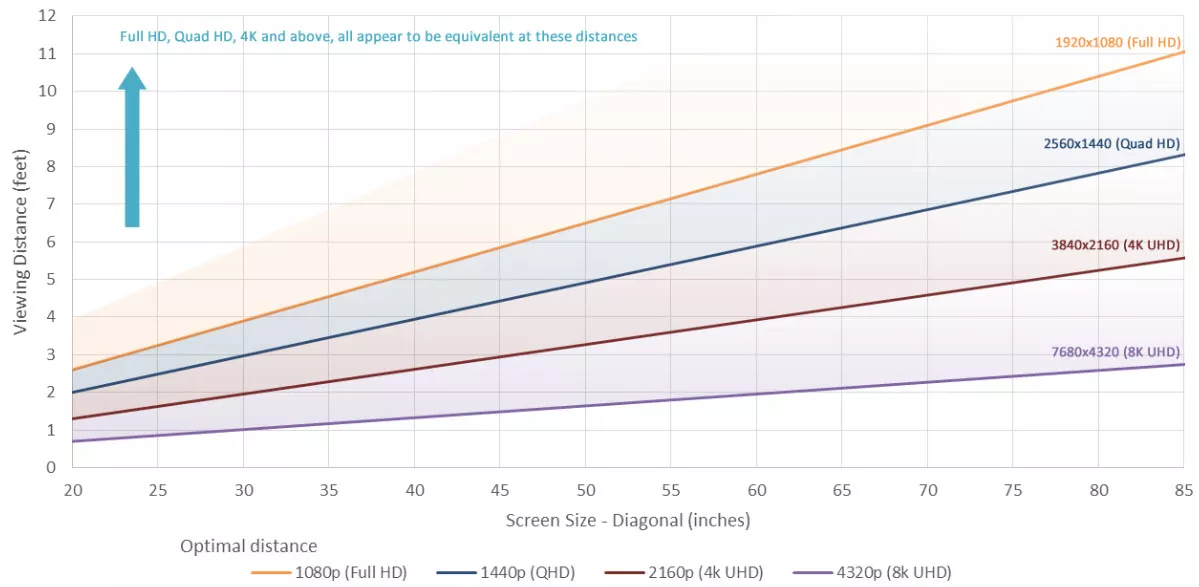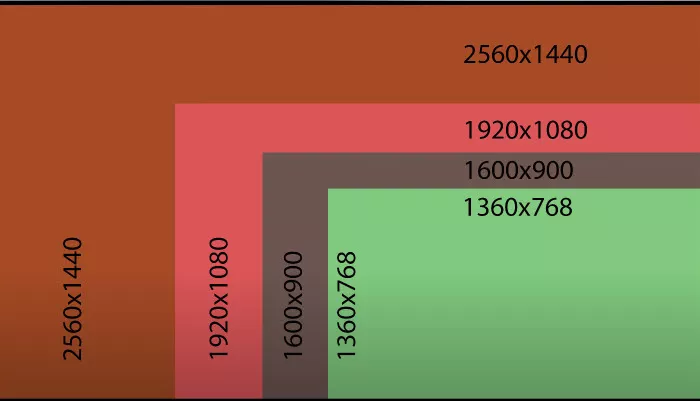1080p vs 1440p: Which One Is Best For You
We have a complete study about the 1440p resolution in this article, while this is a comparison between two resolution 1080p vs 1440p
The comparison of 1080p vs 1440p is that 1440p resolution doubles the pixels of 1080p (4) and enables the user to enjoy more sharpness accuracy (1) while simultaneously being able to experience much higher refresh rates. The current industry-standard recommendation is 1440p for most advanced users such as designers and gamers (5). Therefore, we recommend currently a 1440p monitor of 27 inches with a high refresh rate (6), provided that the user sits at a viewing distance of a maximum of 3ft or 90 centimeters from it (3).

In the comparison 1080p vs 1440p, we can define that 1440p is better than 1080p as this resolution provides more screen surface workspace footprint, more sharpness accuracy in image definition, and larger screen real estate.
However, you should keep reading this article as you have to consider other factors, such as enjoying a higher refresh rate (240hz vs 144hz), the performance of your hardware, the distance between the user and the screen (2), and notably, the size of the surface of the screen.
1440p vs 1080p, 4k, 720p, or whatever resolution we can discuss, does not tell us alone, neither which has a better picture definition nor how a sharp a picture on the monitor is. In fact, sharpness means PPI (pixels per inch). A 32″ 1440p monitor has the same “sharpness” as a 24″ 1080p. So you always need to consider the real estate of the screen as well.
What Is 1080p And What is 1440p
1080p is the shortened form for a screen resolution of 1920 by 1080 at an aspect ratio of 16 by 9. It is the resolution of the iconic Pioneer Kuro.
Applies to 1080p TV / Display / Media resolution where “P” means resolution “progressive,” which means there is a true 1080 vertical line. FHD / Full-HD is the other most commonly used term for marketing this resolution.1080p refers to the display / content ratio of 16: 9.
1080p in Full HD offers up to five times better image quality than 720p, which is a significant improvement and is not something you can just simply upscale from 720p to 1080p. It is the right choice for TV monitors ( as the iconic Pioneer Kuro) and laptops, but it is suitable for conventional gaming consoles like PlayStation 1 and 2.
1080p requires less storage space, CPU power for decoding, and bandwidth (less buff) for transmission. 1080p supported by lots of hardware and easy to edit (requires a low beam computer). 1080p recorders are inexpensive, and there are several different types.
1440P stands for a resolution of 2560 by 1440 pixels also at a 16 by 9 aspect ratio.
1080p is also known as Full HD whereas 1440p is considered to be QHD, as it is offering four times the screen resolution of a 1,280 x 720 HD display, or more accurately called WQHD wherein the “W” stands for “Wide”.
Resolution is referring to the size of the monitor in terms of pixels. E.g. A 1440p resolution displays 2560 horizontal pixels and 1440 vertical pixels. As you increase the monitor resolution you are displaying more pixels resulting in an increase in visual image quality and clarity.
But what do these numbers actually stand for when we are talking of screen resolution? it’s the pixel count by multiplying 1920 by 1080 that tells us we’re looking at a pixel count of roughly 2.1 million about 3.7 million pixels when multiplying 2560 by 1440. So to keep it simple the more pixels or dots a monitor has the clearer and sharper the image
MORE PIXELS = SHARPER IMAGE
The very first difference between 1080p and 1440p is the workspace. Clearly, at 1440p you can fit a lot more in the Windows taskbar as well as on a desktop in terms of icons but also Windows in general.
With 1440p, you can fit more images and content than in a 1080p without requiring any resizing or refitting.
The same happens for websites when surfing the web. Thanks to the larger workspace, with 1440p, websites are displaying more information without the need to scroll as much as with 1080p.
The benefit of increased workspace pretty much applies to lots of situations indeed very beneficial for image and video editing works.
1440p resolution was regarded as a possibility for the television media to go beyond the former 1080p. Nevertheless, finally, the television industry skipped this 1440p resolution in the benefit of 4K resolution or UltraHD. 4K offers 3,840 x 2,160 resolution or four times that of 1080p. The television industry finally dropped the utilization of 1440p in favor of 4K.
Despite this aggressive decision from the television industry, it positioned well in the consumer electronics space and smartphones and is one of the favorite resolutions among gamers and business users.
1080p vs 1440p Gaming: 1440p Pros And Cons
What about gaming? Are there benefits in utilizing 1440p? This resolution allows games to look at that sharper with smoother edges and curves. However, both 1080p and 1440p aren’t high enough resolutions to fully allow us to keep anti-aliasing and games disabled for a super smooth looking gameplay. This is depending on the screen size of course and pixel density. 1440p is better than 1080p for gaming.
Nevertheless, note that due to a higher pixel count at 1440p compared to 1080p the GPU, your graphics card, will be working with more pixels. This means that performance will take a hit accordingly thus leaving you with a lower frame rate as with 1080p for instance. Nowadays, in modern graphics cards these days, the FPS count doesn’t drop too dramatically.
I think you should dismiss 1080p if you have the chance and upgrade to 1440p for the following reasons:
1440p Pros
More screen real estate
The first reason on my list is that you get more screen real estate with 1440p. A 1440p monitor has 78% more pixels than a 1080p monitor. A 27-inch 1080p monitor has about 78 pixels per inch while a 27-inch 1440p monitor has about a hundred and eight pixels per inch.
This represents as you can see a thirty-eight percent difference between PPI. Therefore, the 1440p monitor is going to be crisper, meaning that you will retrieve better quality on the same screen.
The great advantage of the screen real-estate is that it increases productivity. When I upgraded to my 1440p monitor I could get more done in less time just because I had more space to manage my windows and resources.
1440p monitors are marginally cheaper
Cheaper and decent quality monitors are becoming more readily available so if you are kind of worried about the price you can still get a pretty decent 1440p monitor for the price of a decent 1080p monitor.
1440p Cons
1440p has higher performance requirements
Running at 1080p resolution is considered the entry-level and is a great option if you are on a tight budget or a competitive gamer. Many competitive gamers play at 1080p for two reasons, firstly running a lower resolution has lower performance requirements which makes it much easier to achieve higher frame rates to play at the higher refresh rate of 240Hz.
Thus, a disadvantage of 1440p is that it requires more bandwidth to transmit and takes up more than 1080p of storage space. An active graphics card is required to achieve a playable frame rate.
In 1080p It Is Easier to See All The Screen In Action Games
Secondly, competitive gamers tend to prefer playing on smaller 24 Inch monitors so that everything on the screen can be seen without needing to move your head. You can see that a 24-inch monitor is well suited for 1080p gaming as well.

Few Advantages In 1080p
But there’s also a dark side to 1440p or higher resolutions in general and that is readability. This happens because more and more pixels are crammed into the screen.
Therefore, while the workspace increases, to actually obtain that extra workspace, the content is required to shrink. Thus, if the screen size remains the same (two 27-inch
screens one with the 1440p resolution and the other one with 1080p) the text and windows will appear to be much much smaller at 1440p than at 1080p.
This means that certain users might have a hard time reading text on high-resolution screens to compensate for the actual content size, you’d have to increase your actual screen size because the screen resolution has to be always analyzed in reference to the aspect ratio of the screen.
Nevertheless, a huge benefit at 1440p is the improved sharpness and image clarity overall. Everything just looks much sharper.
Conclusions
In the 1080p vs 1440p discussion, 1440p has to be the preferred option here and your best option is a 1440p with a very high refresh rate (240Hz) and a screen of twenty-seven inches. This statement considers a normal sitting distance.
Only if it is very expensive for you, settle with 1080p but in any case, always select a high refresh rate of 240Hz.
Related Articles
We have a complete study on 1440p resolution, defined a video framework sitting at 1440p with 60 FPS, and answered the question is 1440p 4k in the gaming or cinema industry?
We have also compared 1440p vs 1080p and 1440p vs 4K. We reached the conclusion that the best resolution for you is not always the highest one, but it depends on many factors, such as the size of the screen, the refresh rate, the distance with the display ad the activity to be performed.

I am Bob. I work as an audio engineer and audio technician. I work in mastering and arranging bridges in existing songs and the arrangement and orchestration of the chorus. In Planet HiFi I test gear for a couple of days and write a review. I also write about AV topics, amplifiers, speakers, and headphones.


Emerson
Monday 4th of July 2022
Hello: The more I research the more confused I get. I'm buying a new desktop with a blu ray player, NVMe SSD and what they tell me is 12th generation i5. For my uses I don't play games so it'll be web surfing, Word/Excel, and dvd blu-ray watching. I'd like to upgrade to a 32" monitor. Will 1440p be a worthwhile upgrade or will it make Word documents and web pages too small to read? Will the quality of the blu ray look better?
Thanks!
Brian
Friday 3rd of March 2023
@Emerson,
Even if the documents are smaller, you can scale the size up by adjusting it in windows. So they will/can be the same size, just sharper.